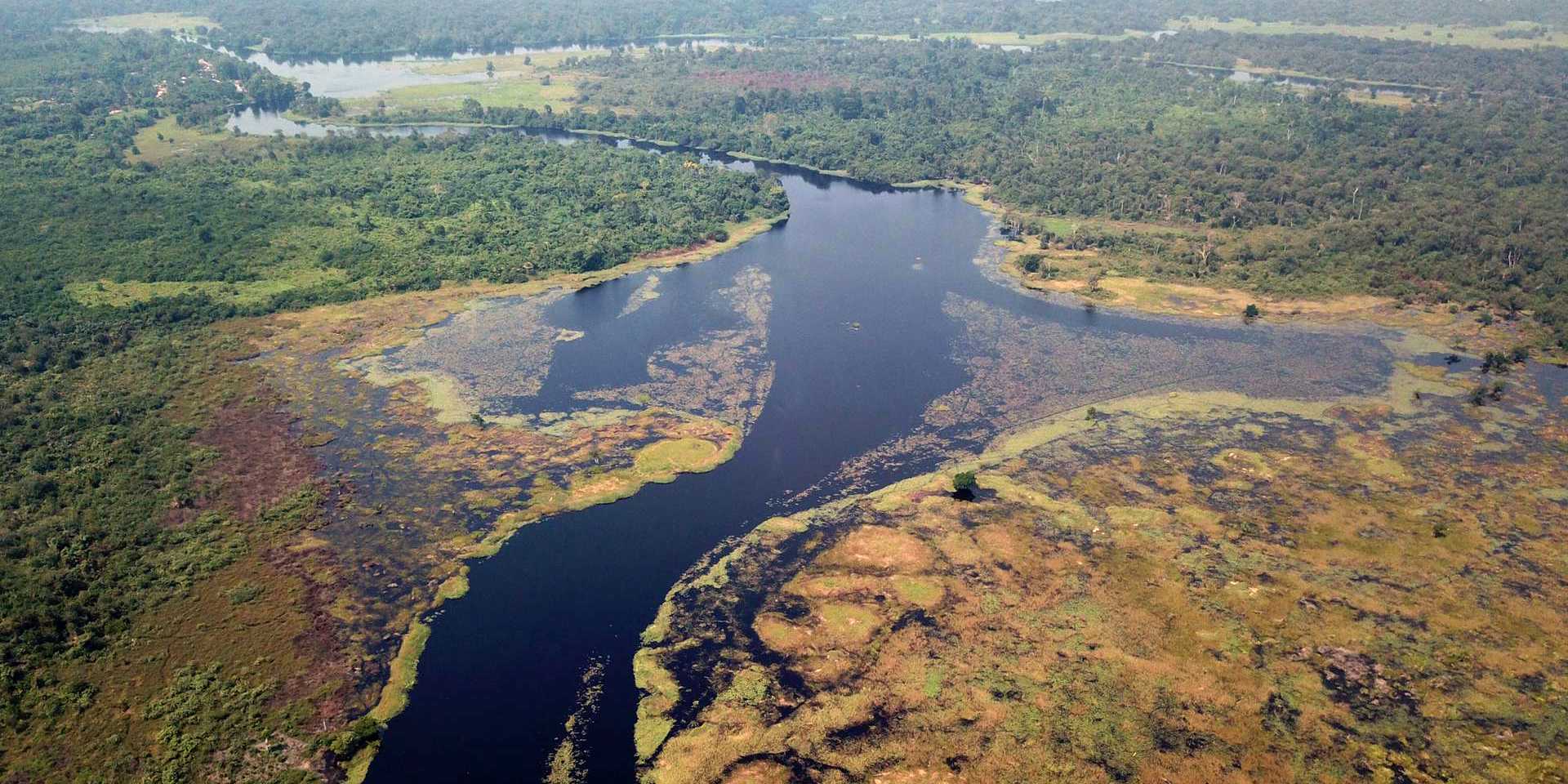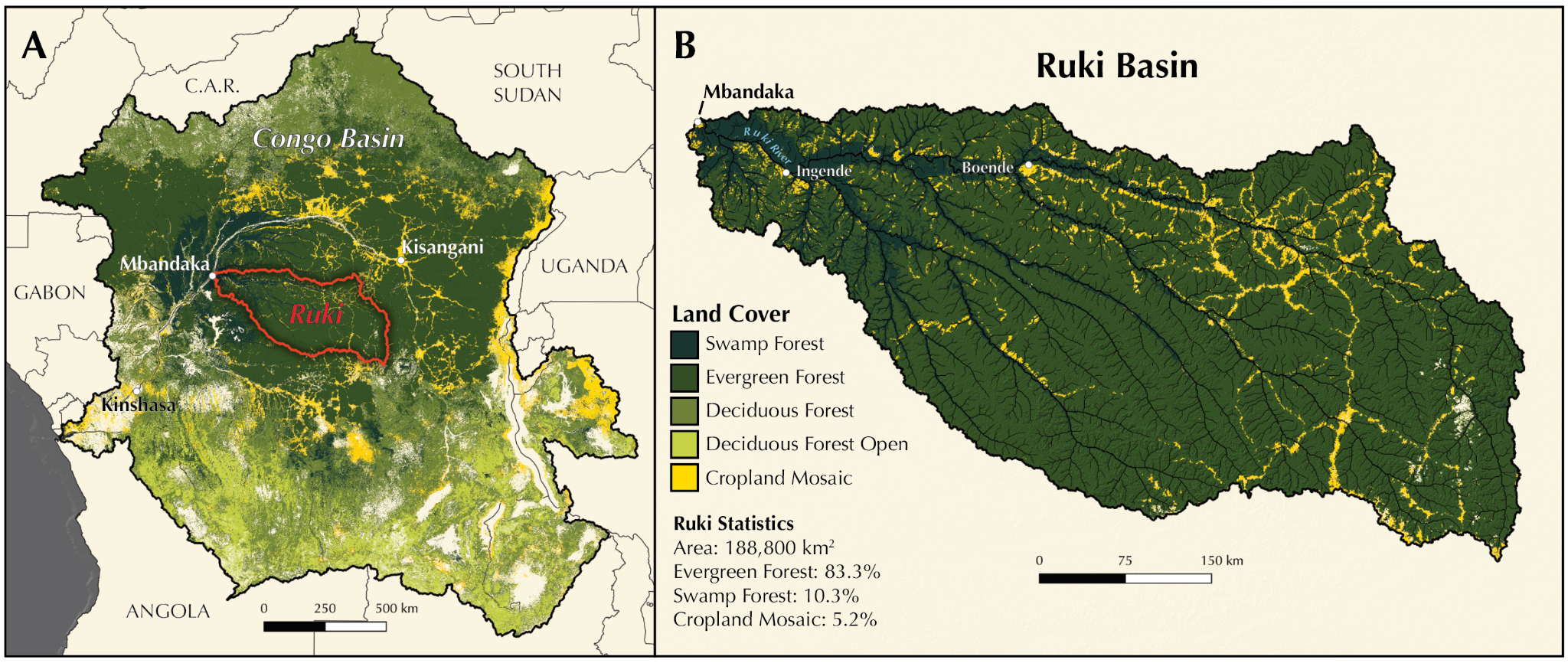
They set out to study the Congo Basin's carbon cycle and in the process discovered one of the world's darkest blackwater rivers: the Ruki. In the first study on this major jungle river, an international research team led by ETH Zurich explains how this blackness comes about and what it says about the river system's carbon balance.
In brief
- The Ruki River in Congo is one of the darkest blackwater rivers in the world due to its high content of dissolved organic matter.
- The organic matter comes mainly from forest vegetation.
- Peat bogs along the river currently release very little organic matter into the Ruki because the bogs are submerged for most of the year.
When the researchers came upon the Ruki River, they were quite taken aback. The water in this river, a tributary of the mighty Congo River, is so dark that you literally can't see your hand in front of your face. "We were struck by the colour of the river," says ETH Zurich researcher Travis Drake, who has just published a study on the Ruki together with colleagues from the Sustainable Agroecosystems Group, led by Johan Six, as well as from other universities.
Comparisons with other major tropical rivers show that the Ruki may even be the blackest large blackwater river on Earth - it's certainly a lot darker than the famous Rio Negro in the Amazon.
The reason the water is black is that it contains large amounts of dissolved organic material and hardly any sediment because of the river's low gradient. These carbon-rich substances are mostly washed into the river by the rain, which falls on dead jungle vegetation and leaches out organic compounds from the decomposing plant material. What's more, the river floods the forest in the rainy season. It can take weeks for the often waist-deep water to slowly retreat, during which time it leaches organic substances. "The Ruki is essentially jungle tea," Drake says.
Peaty bogs and virgin rainforest
It's not just the dark water that's special. The Ruki, which is one kilometre wide and empties into the Congo, is unique in its entirety. Its drainage basin, which is four times the size of Switzerland, is still covered by untouched primary lowland rainforest. Along the river, there are big peat bogs containing gigantic amounts of undecomposed dead plant material, which makes them significant carbon sinks.
Despite its uniqueness and size, the Ruki has never before been scientifically studied. While the river's different seasonal water levels have been documented since the 1930s, no data on its chemical composition has been available up to now. Nobody had yet determined how much dissolved organic carbon (DOC) is in the water and, above all, where it comes from.
So in 2019, Drake and his colleagues set up a measuring station near the city of Mbandaka, a short distance upstream from where the Ruki and the Congo converge, and measured the water discharge every two weeks and daily water level for a year to determine the annual streamflow.
"Our measurement methods on site were quite basic," Drake says. He relates that Mbandaka has no permanent power supply, only a few diesel generators and hardly any infrastructure - not even a power drill to install the flood level marker. "So we often had to improvise," he says with a smile.
What water samples reveal about the Ruki
Water samples were collected with each discharge measurement and sent to the lab at ETH Zurich for analysis. There, the researchers determined the samples' DOC content as well as the age of the organic material based on the radioactive carbon in the DOC. Among other things, they wanted to find out whether the peat along the river releases carbon (and at some point decomposes into CO2).
The researchers decided to examine the water because it contains carbon signatures from the entire drainage area, which in turn convey information about origin and land use. The advantage of water analysis: "We need to collect samples from only one location to gain information about a huge area - like a doctor who takes a blood sample to determine the condition of a patient's health," says the study's coauthor, Matti Barthel.
Unexplored hydrology
The analyses confirmed the visual impression: "The Ruki is one of the most DOC-rich river systems in the world," Barthel says. Its water contains four times as much organic carbon compounds as the Congo's and 1.5 times as much as the Rio Negro's in the Amazon.
And although the Ruki's drainage basin makes up only a twentieth of the entire Congo Basin, a fifth of the dissolved organic carbon in the Congo comes from this one tributary.
DOC usually comes in the form of organic acids that increase the acidity of the river water. This stimulates the release of carbon dioxide (CO2) as the acids dissolve carbonates present in the water. "CO2 emissions are relatively high across the Ruki's entire drainage basin but not dissimilar to other tropical rivers," Drake explains. This is because the Ruki is a sluggish and placid river, which makes it more difficult for the CO2 in the water to escape into the air. "In a turbulent river, we'd see higher emissions," he says.
According to Drake, the carbon isotope analysis also shows that most of the carbon comes from the forest vegetation, not the peat. Only for a short period of time at the end of the rainy season between March and April, after peak flow, do the researchers find evidence of the peat bogs releasing carbon into the water. It's not clear how and why this happens at that particular time. "Overall, however, we see very little peat in the river," Drake says. "And that's good news, because it also means that the peat bogs are stable."
At present, he says, there is no danger that the organic material contained in the peat bogs will be released, since they are under water almost all year round and thus not exposed to oxygen. However, extractive companies have taken an interest in the Ruki Basin's natural resources, which include oil and gas, and a first batch of concessions have already been granted. Changes in land use such as deforestation could alter the river regime. This might lead to peat bogs falling dry and being decomposed by bacteria, which would release a huge amount of CO2. "The peat bogs in the Congo Basin store some 29 billion tonnes of carbon," Barthel says. "It would be better for the climate if they stayed wet."
A long-standing research project
Johan Six and his group have been studying the Congo Basin's carbon cycle since 2008. The Congo is one of the most important tropical river systems on Earth. It carries huge amounts of carbon out into the sea. The vegetation in its drainage basin affects its carbon cycle, as does land use. It was during a scouting trip to study the carbon cycle - the biogeochemistry - of the Congo Basin that the researchers came across the Ruki River.
After their side trip to the Ruki, the scientists are now studying other tributaries of the Congo, such as the Kasaï and the Fimi River - and completing the carbon puzzle piece by piece.

Reference
Drake TW, Barthel M, Mbongo Ekemba C, et al. Hydrology drives export and composition of carbon in a pristine tropical river, Limnography and Oceanography, 13 October 2023, doi: external page10.1002/lno.12436







